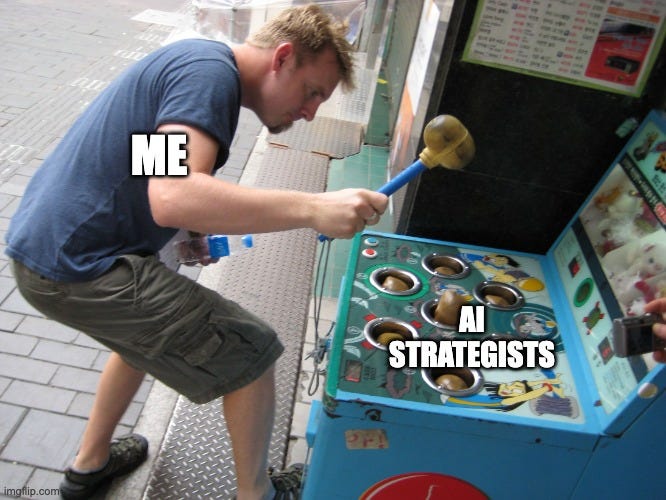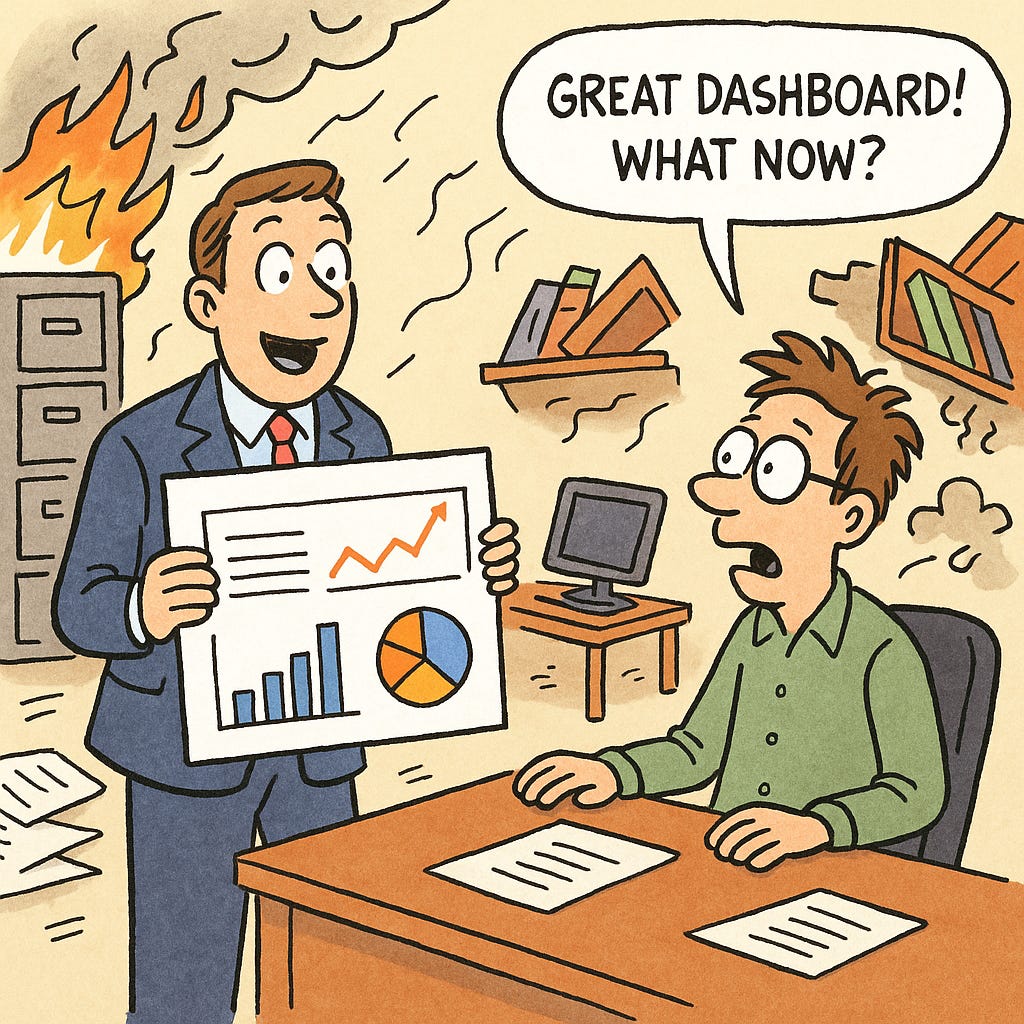Signal Overload
The paradox of 'insights-at-scale'
Data conference season is officially upon us, and I’ve found myself at two in as many weeks. Unsurprisingly, AI dominated the agenda.
These days, you could throw a rock into a crowd and almost certainly hit a self-proclaimed AI expert (please don’t, tempting as it is). So my first challenge was to figure out who actually knew their stuff versus who just liked the sound of their own voice.
Cynical side-note: that’s getting harder.
Thankfully, I did come across a few bona fide experts, the kind who’ve actually done the thing they’re talking about. Otherwise, it feels like we’re playing a never-ending game of AI grifter whack-a-mole. They just. Keep. Coming.
(They’re not all bad)
I found myself drawn to a couple of discussions on AI’s impact on insight generation. That word, insights, always lights up my radar. It’s hands down my favourite part of the entire data game. I’ve never been fascinated by data for data’s sake. What I love is what we can do with it. That aha moment, when you realise the data is telling you something genuinely useful, something that helps drive a smarter decision or a new course of action.
I know I should get out more, but I flipping love the process of insight creation, and have done ever since I was a newly minted analyst.
Quick aside to make the point:
A few years ago, my team was reviewing sales data from a retailer who challenged us to tell them something they didn’t already know. Fifteen minutes into some quick exploratory analysis, our data scientist discovered a weird correlation: watermelon seeds (I’ve still not seen these in real life) correlated with higher overall basket sizes. It was something of a keystone product.
It turns out those buying this product skewed heavily toward an affluent, health-conscious demographic (picture yoga devotees and smoothie lovers). So we dug into store catchment data, identified where that demographic was overrepresented, and advised the retailer to stock more melon seeds there.
That fifteen-minute insight generated an incremental £2 million in the next quarter. From one tiny, quirky insight. That’s why I love this stuff.
(Licence to print money, apparently)
So, when I heard both speakers talk about AI delivering insights-at-scale, I perked up. I’ve seen what this looks like in practice, using AI to surface patterns, predict outcomes, and uncover opportunities at speed. In customer and marketing environments, machine learning has been doing the heavy lifting for years, so its not new.
What is new is this tech is increasingly available to all sorts of organisations, with all sorts of problems.
Both speakers pitched insights-at-scale as an unequivocal advantage. After all, who wouldn’t want better insights, faster?
It can be an incredible advantage there is no doubt about that.
Yes, you guessed it, there is a ‘but’ coming.
You’d think, given my background, I’d be cheering. But actually, my seasoned analyst brain bristled a little.
Not because I’m anti-AI. Not because I have an issue with scale. But because I don’t believe most organisations are remotely ready to do anything useful with insights-at-scale, unless they have been specifically set-up to deal with them.
As usual, my concern isn’t about the tech or the ambition, it’s about the business fundamentals. What good is a flood of insights if the organisation doesn’t have the structure, mindset, or capability to act on them?
That’s the real question: not whether AI can scale insights (it can), but whether we’ve built businesses that are capable of responding to them (we often, haven’t).
Because otherwise, it’s just noise. At scale.
Abundant insights, new pressures
Fast flowing insights challenge how decisions are made, how organisations are structured, and even how strategic value is defined.
An abundance of insights can create a paradox. The more data-driven you strive to be, the more friction you encounter when it actually comes to acting on the data.
In my experience, many organisations are investing heavily in AI and analytics platforms, yet few are seeing a proportionate return of strategic impact. Dashboards multiply, models proliferate, and somehow decision-making remains sluggish.
So, something is amiss.
The issue isn’t the insights. It’s a lack of organisational readiness to absorb and act on them. AI doesn’t just amplify insights, it amplifies the pressures that come with interpreting, trusting, and operationalising them.
Scaled insights can reveal systemic strain
When AI starts surfacing real-time recommendations, across areas like customer experience or operations, the velocity of decision pressure increases.
All to often our organisations become exposed to:
Conflicting insights from different models or tools.
An unmanageable volume of signals, each calling for attention.
Cultural resistance to machine-generated guidance, especially when it challenges human judgment.
AI creates a new kind of leadership burden; ensuring our processes and culture are ready and able to deal with the volume and velocity of insights thrown at them.
(A burdened leader)
The hidden dependencies of scalable insight
I’m not having a pop at these esteemed speakers. They both did a better job on stage than I could, and they were there to evangelise AI, to be fair to them.
Yet for all the enthusiasm around AI-driven insights, it seems most conversations gloss over the infrastructure of readiness we require to make them useful. When we talk about scaling insights, we’re not just talking about scaling data processing (that is easier than ever), we’re talking about scaling, sense-making, decision-making, and meaningful action (these are as difficult as they have ever been).
When thinking about the infrastructure of readiness, there are four important components (there may be more - tell me in the comments).
Clarity of business goals and KPIs
Insights without context are not really insights, just random information. We have to remember that context is all - and this comes from clarity around what matters.
Many organisations still struggle to articulate crisp, measurable business goals across functions. Without a clear line of sight of what we’re trying to influence, insights tend to drift into abstraction. Even worse, teams may chase metrics that are easy to measure but strategically irrelevant.
When you scale insights, the risk multiplies. You don’t just get more information, you get more potentially distracting information. Without aligned KPIs and clearly prioritised objectives, you risk misallocating resources to optimise what can be measured rather than what should be moved.
We know that good analytics requires a rigorous hierarchy of goals and KPIs to shoot at, and the same goes for AI-generated insights. If you can’t connect those insights to business value, than you’re wasting your time.
Decision-making processes that can absorb insight
Imagine surfacing 100 micro-insights per day, each with the potential to tweak pricing, stock levels, campaign creative, or customer journeys. Now imagine needing a meeting to act on each one. That’s not scale, that’s gridlock.
Most businesses aren’t set up to absorb and act on a high volume of insights. Legacy decision rights, slow approval cycles, and vague accountability blur the line between insight and action.
We need to consider our decision architecture:
What decisions can be automated?
Who owns which types of decisions?
What are the escalation paths?
How fast can the loop from insight to action close?
Without this clarity, insights-at-scale fall into the bucket of unrealised potential.
This is why so many data-forward organisations are focused on developing distributed, agile decision-making models that can act on insights autonomously where possible, and escalate smartly where needed.
Cultural readiness to trust and use data
All the insights in the world won’t help if no one believes them, understands them, or wants to act on them.
This is often the biggest hidden dependency: culture.
In many organisations, data still sits in a specialist silo. Teams default to experience or gut feel. Or worse, they use data selectively to justify decisions already made.
Insights-at-scale only works when data is everyone’s job:
Business users trust what the data says.
Leadership rewards evidence-based decisions.
There's psychological safety to act on uncomfortable truths.
People are curious, not threatened, by what the data reveals.
It is vital we focus on developing cultures that see data as a partner, not a threat, and rewards the use of insights to drive change.
Organisational capability to operationalise insight
Generating insight is the midpoint, not the endpoint. The real question is: can the business do something with what it knows?
This is where capability gaps often hit:
Can marketing teams pivot creative quickly based on changing performance signals?
Can supply chain teams reallocate stock dynamically in response to shifting demand?
Can product teams prioritise roadmap changes based on usage patterns in near-real time?
Insights-at-scale demands execution-at-scale. If your teams aren’t resourced, skilled, or empowered to act quickly and smartly, insights end up trapped in dashboards, not making a difference.
This places emphasis on cross-functional capability to integrate insights into workflows, tools, and day-to-day actions.
Solving the Challenge of insights-at-scale
Okay, I can’t resolve this in one article. But the onus is on data leaders to design organisations that are insight-responsive, not just insight-rich.
Here’s some thoughts on potential approach:
Anchor everything in business outcomes
You need to start with the ‘why’ before scaling the ‘what.’
Before you light up the AI engines, you need to get crystal clear on the business decisions you want to improve. This isn’t just about setting KPIs, it’s about asking:
What decisions do we want to make faster, smarter, or more frequently?
Where are the highest-value opportunities to improve outcomes using data?
What does ‘good’ look like for our use of insights?
Design for action, not just analysis
Remember, insights are only as good as your ability to act on them.
Most organisations build reporting and analytics functions, but don’t build decision systems. You need to design your processes for closed-loop action.
That means:
Streamlining decision rights (who acts on what insight?).
Building automated response loops where possible.
Empowering frontline teams to act on relevant, near real-time data without waiting for approval.
(Remember, design for action)
Build a culture of data curiosity and trust
Okay, this one is not easy, but you need to gain belief. People have to want to use insights.
Shifting culture is hard, but never optional. You need to normalise the use of data in everyday decisions, and make insight-actionable behaviour part of how performance is evaluated and rewarded.
This includes:
Telling stories of impact when insight leads to value.
Celebrating curiosity and experimentation.
Making decision literacy a core part of leadership and team development.
Invest in the last mile of insight: execution
Don’t just tool up for insight discovery, tool up for insight delivery.
AI, analytics platforms, and dashboards are often over-invested in. What’s underfunded is the operational layer, the ability to integrate insights into day-to-day tools and workflows.
This includes:
Embedding insight flows into CRM, supply chain, or CX system, not just dashboards.
Training cross-functional teams to interpret and apply insights in their context.
Training up translators, people who can bridge data and decision-makers, turning analytics into action.
Shift from insight generation to insight enablement
The real opportunity in insights-at-scale isn’t just about speed or volume, it’s about empowerment. The ability to put better decisions into the hands of more people, more often.
Solving the challenge means shifting from:
Reporting to decisioning
Centralised analysis to distributed action
Knowledge hoarding to knowledge enabling
They key has always been to design a system that makes use of insights, by default. The rapid emergence of insights-at-scale, is placing greater emphasis on this than I’ve ever seen.
That’s one good thing thing about AI, it’s a trigger to get our data houses in order.







Great article! I think that data translators are going to be key enablers of decision making beyond consuming data from reports.
I’m going to discuss one of the things you mentioned in an upcoming article.